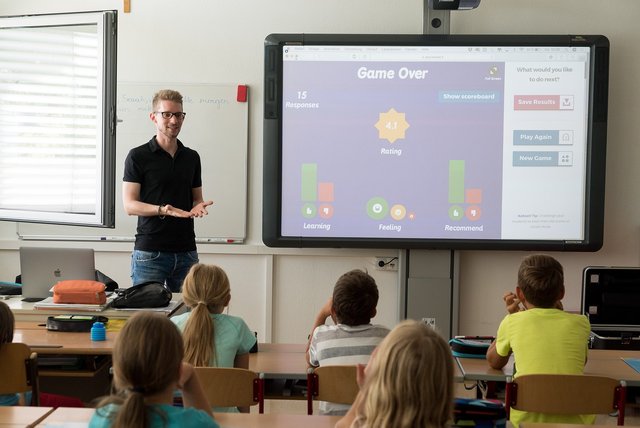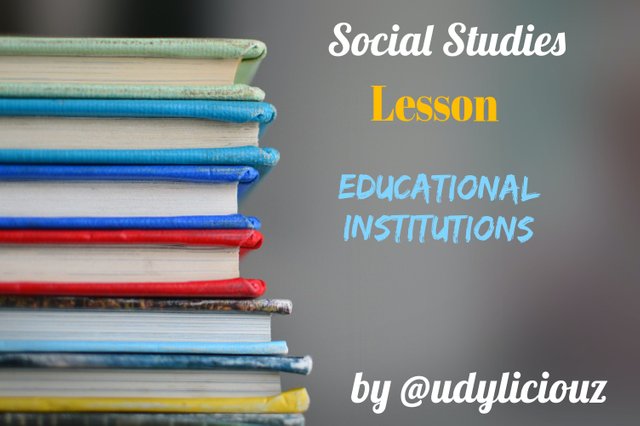Social Studies lessons: Educational Institution
Introduction
The societal values, customs and tradition are passed down from one generation to the other through educational process. Therefore, this lesson discusses the concept of education, types of education, and levels of educational institutions In addition, school as an educational institution, members of a school community, roles of school to the community as well as the roles of community to the school are discussed.
Meaning of Education
Education means the imparting and acquiring of knowledge, skills and right types of attitude. It is a form of learning in which the knowledge, skills and habits of a group of people are transferred from one generation to the next through teaching. training or researching. In essence, acquisition of worthwhile skills, attitude and skills are guaranteed through education.
However, education is not limited to classroom situation or school setting. It can take place anywhere and at anytime. This is expatiated in the next session.
Types of Education
Three types of education has been identified. These are:
Informal education
Non-formal education
Formal education
Informal Education: This can also be referred to as traditional education. It is the type of education that takes place on daily basis in an informal setting. It does not require special curriculum, teacher, time, place and regulation.
For instance, children learn some skills, attitudes and values from their parents and elderly people in their environment. Female children learn cooking skill and other home management skills from their mother, informally. Male children also pick up some habits from their father or uncles by imitation.Non-Formal Education: This includes all forms of functional education given to children, youths and adults outside the formal school system such as practical, remedial and vocational education. This form of education is similar to formal education but with flexibility. In non-formal education. curriculum, teachers and some rules and regulations exist. However, the curriculum and rules are not rigidly applied as applicable in formal education.
The learners are at liberty to influence implementation of non-formal education curriculum. This is because learners can decide on what to be taught. For example, an adult who is computer illiterate can decide to enroll with a computer training institute and pre-select an aspect he or she wishes to learn.Formal Education: This is the type of education that takes place in a formal setting i.e. school system. It has a special curriculum to be implemented, teachers with minimum teaching qualifications, designated place called school, rules and regulations to follow and timeframe for the instructions. It is a systematic, organised education model, structured and administered according to a given set of laws and norms, presenting a rather rigid curriculum as regards to objectives, content and methodology.

Source A formal educational setting
An example of formal educational structure is the 9-3-4 system of education practised in Nigeria. The basic education is meant for 9 years covering 6 years primary education and 3-year Junior Secondary education. The next level is the 3-year Senior Secondary education while the last stage which is 4 years is meant for Higher education.
Levels of Education
Levels of education refers to the education given to people at different levels of life from infant to adulthood. The following are the different levels of education
Early Childhood/Pre-Primary Education
According to National Policy on Education, early childhood pre primary education is the education given in an educational institution to children prior to their entering the primary school. It includes crèche, nursery and kindergarten. The age of children enrolled at this level is between two (2) to five (5) years.
Objectives/Goals of Pre-Primary Education
The objectives of this level of education include effecting a smooth transition from the home to the school, inculcating social norms and preparation of child for primary level of education.
Primary Education
Primary education refers to education given in primary schools for children aged (six) 6 to eleven (11) plus. We have six years in this level of education.
Goals of Primary Education
The goals of primary education, according to National Policy on Education are: inculcating a permanent literacy and numeracy and ability to communicate effectively; laying a sound basis for scientific and reflective thinking, giving the child opportunities for developing manipulative skills that will enable him/her to function effectively in the society within the limits of his capacity, etc.
Secondary Education
This is the next level of education after primary education. Secondary education covers both junior and senior secondary schools. At the junior secondary, students are exposed to a number of subjects from which they will make their choice when they get to senior secondary school. At the senior secondary, students select combination of subjects based on their interests and levels of intelligence. The areas of specialisation are science, commercial and arts. We also have six years at this level of education, three for junior and three for senior secondary schools.
Goals of Secondary Education
The broad goals of secondary education are preparation of individuals for useful living within the society and higher institutions; raising a generation of people who can think for themselves; respect the views and feelings of others; respect the dignity of labour; appreciate those values specified under our broad goals; and live as good citizens.
Tertiary Education
This is the next level of education given after secondary education in Universities, Colleges of Education, Polytechnics, Monotechnics including those institutions offering correspondence courses. Here students study courses based on their area of specialisation. We have a minimum of four years at this level of education,
Goals of Tertiary Education
The goals of tertiary education include contributing to national development throug high level relevant manpower training; developing and inculcating proper values for the survival of the individual and society; acquiring both physical and intellectual skill which will enable individuals to be self-reliant and useful members of the society.
School Community
School can be referred to as a social institution which prepares learner for future intellectual, professional as well as social roles in whatever community, society, country in which he or she belongs. School is established to facilitate achievement of goals of formal education. It is also known as one of the agents of socialisations. Another name we can call a school is an educational institution.
Roles of the School to the Community
The school plays the following roles to the community where it is located:
i. The school produces manpower for the community or society.
ii. The school helps in inculcating into members of the community/society the needed knowledge and skills.
iii. The school helps in passing down some of the societal cultural norms and values to members of the community.
iv. The school premises/compound is used for community functions.
The school provides job opportunities to members of the community.
Roles of the Community to the School
The community plays the following roles to the school:
i. The community helps the school by providing land and space for the establishment of schools.
ii. Members of the community are used as resource persons in the school.
iii. Philanthropists in the community or society help in donating and financing the school in one area or another.
iv. Members of the community help in the disciplining of students.
V. The community also provides amenities for members of the school staffe.g school workers living in the community.
Homework Task
- What do you understand by the word "education"
- Mention and explain types of education.
- Highlights different levels of education and their objectives.
- Mention 5 roles of school to the community
- State three roles of community to school.
Rules
- Your homework post should be at least 300 words.
- Post in steem kids and parents Community
- You must belong to any of these clubs, club5050 club75 and club100
- Use the hashtags 'health, learnwithsteem, steemexclusive, yourcountry, and your club status as part of your hashtag.
- Drop your entry link at the comment section.
All participants who perform well will be rewarded.
Note: The homework is open to everyone
Booming vote for three outstanding writers.

Am very happy to see another social studies homework task and i cant wait to drop my entry
I trust what you can do and I am waiting for yoyr entry
Okay ma am very happy to hear that
This is my entry link;
https://steemit.com/hive-139765/@vincent100/social-studies-lessons-educational-institution
My entry
https://steemit.com/hive-139765/@radleking/social-studies-lessons-educational-institution
Here is my entry Ma
https://steemit.com/hive-139765/@mjoedavid/social-studies-assignment-or-educational-institutions-by-mjoedavid
My entry
https://steemit.com/hive-139765/@saintkelvin17/social-lessons-educational-institution
My entry
https://steemit.com/hive-139765/@bela90/social-studies-lessons-educational-institution
I invite @manuelhooks,@ gwillchrist and @richy20
In the expansive universe of online educational resources, I recently embarked on a profound journey of discovery, unveiling the top 10 essay writing services https://www.metrotimes.com/sponsored/want-to-buy-essay-online-top-10-trusted-writing-services-to-go-for-30728421 that stand as paragons of academic support. These platforms don't merely offer a lifeline to students; they present a comprehensive array of services aimed at crafting customized, expertly executed essays, potentially reshaping the trajectory of their educational endeavors.